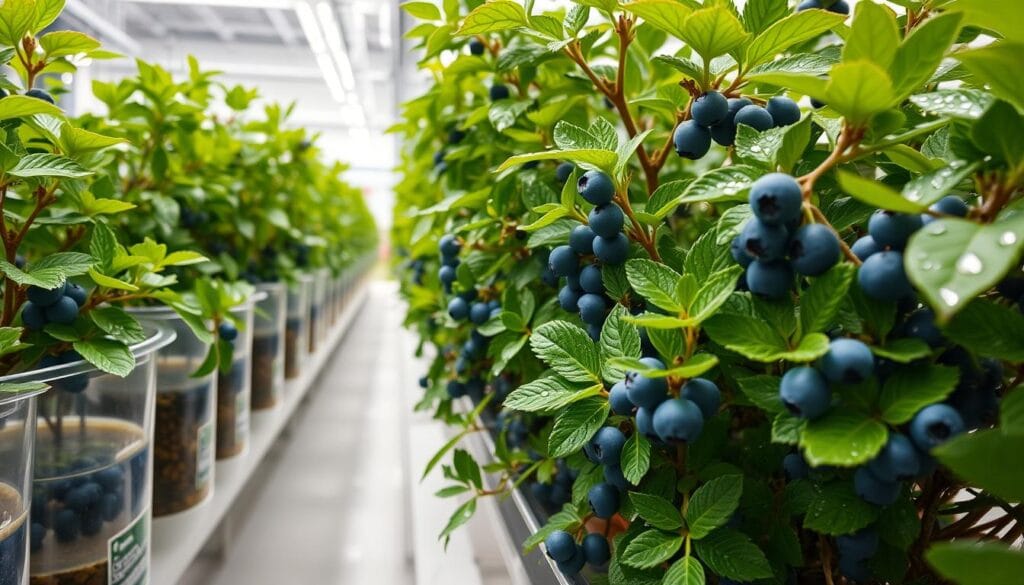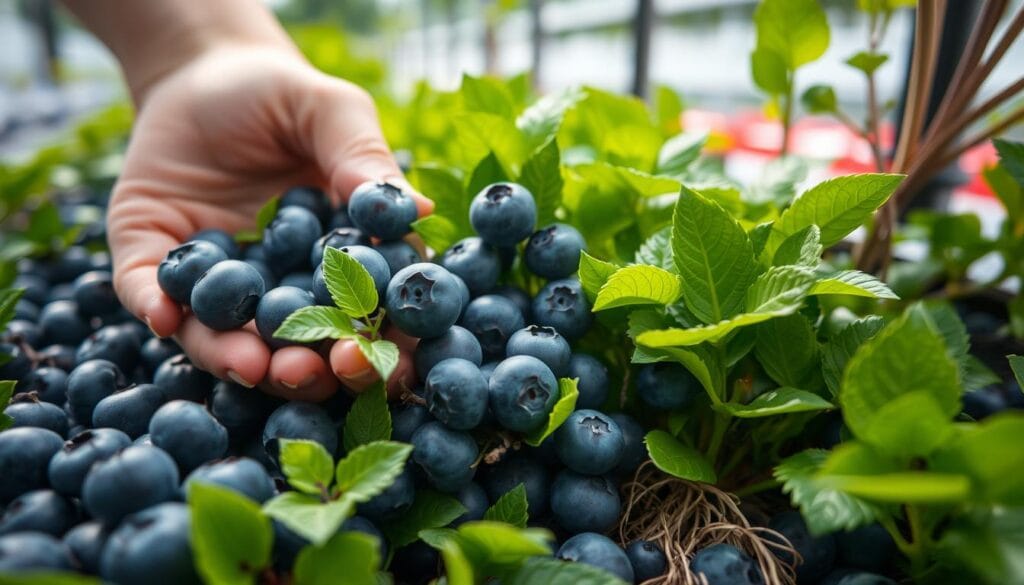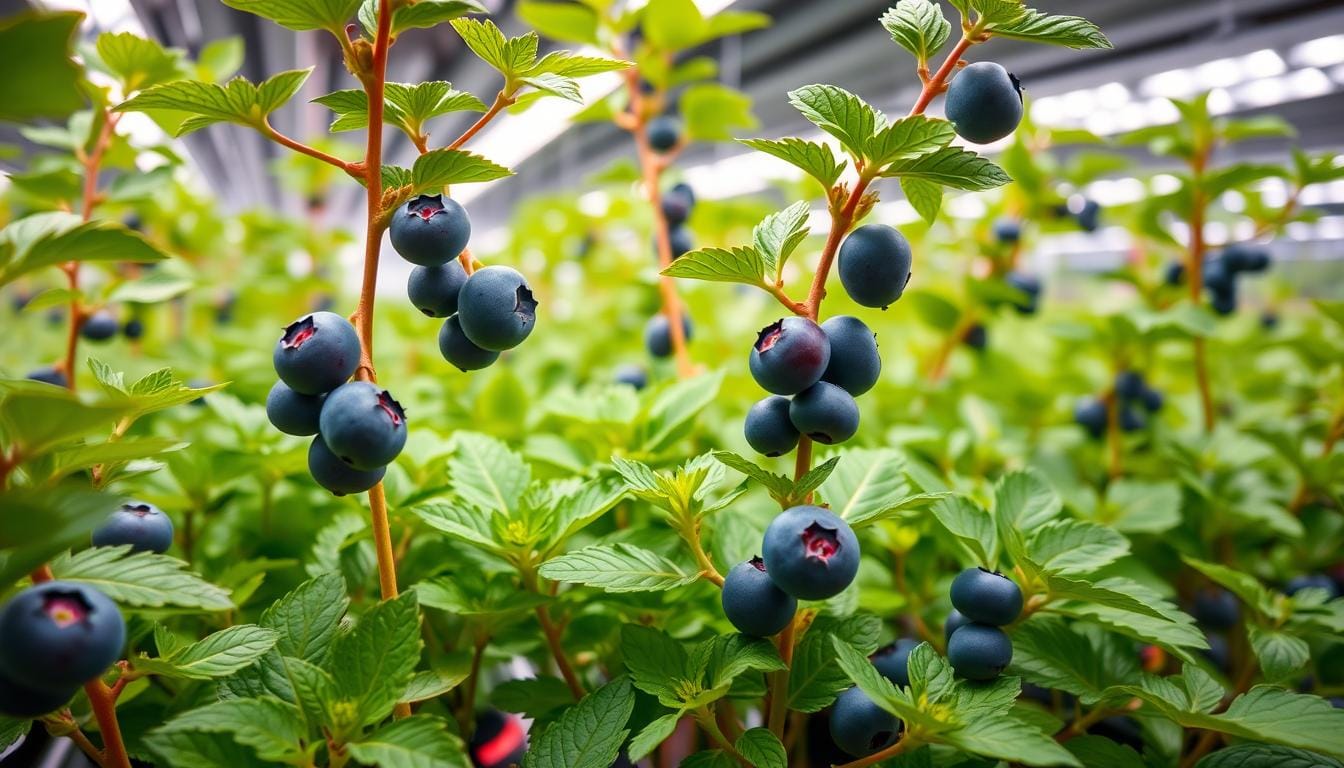Can Blueberries Be Grown Indoors? Yes, they can! Ever thought about growing your blueberries all year, right at home? It might seem hard, but with the right info and care, you can have a big harvest from your indoor garden.
Growing blueberries in a hydroponic system has big benefits. You can see up to a 30% increase in yield and they grow faster. Plus, you use 90% less water. This method creates a perfect spot for blueberries to thrive, even indoors.
Key Takeaways
- Hydroponic blueberry cultivation can increase yields by up to 30% compared to soil-based growing.
- Hydroponic systems use up to 90% less water than traditional soil gardening.
- Blueberries require a highly acidic pH range of 4.5 to 5.8 for optimal growth.
- Precise nutrient management, including ideal ranges for nitrogen, phosphorus, and potassium, is crucial for success.
- Providing the right lighting conditions, with 12 to 18 hours of daily sunlight, is critical for indoor blueberry cultivation.
Understanding Hydroponic Blueberry Basics
Hydroponic systems for growing blueberries can be simple or complex. They offer benefits over traditional soil-based farming. Learning about hydroponic blueberry cultivation can help you fully use this innovative method.
What Makes Hydroponics Different from Traditional Growing
Hydroponics and traditional blueberry growing differ in how nutrients and water are delivered. Hydroponics use a controlled, nutrient-rich environment. This leads to more efficient water use and better pest and disease control. It also means higher fruit yields and the ability to grow year-round.
Key Benefits of Hydroponic Blueberry Cultivation
- Increased fruit yield and quality
- Reduced water consumption compared to soil-based farming
- Improved pest and disease management through controlled environments
- The capability to grow blueberries in tough climates and locations
- Year-round production potential
Common Challenges and Solutions
Keeping the hydroponic solution’s pH and nutrient balance right is key. Growers might face issues with temperature, humidity, pests, and diseases. With the right knowledge and strategies, these problems can be solved. This ensures the growth of hydroponic berries and a blueberry hydroponics system thrives.
Can Blueberries Be Grown Indoors in a Hydroponic System?
Absolutely! Indoor blueberry gardening and blueberry vertical farming are gaining popularity. Hydroponic systems make it easy to grow these tasty berries all year. They provide the perfect environment for blueberries, even in small indoor spaces.
Hydroponic systems have many benefits over growing in soil. They protect plants from bad weather and pests. This leads to better growth and more berries. Dwarf blueberries fit well in indoor setups, making the most of space.
To grow blueberries indoors with hydroponics, you need to control a few things. These include light, temperature, and nutrients. Blueberries need:
- 6-8 hours of direct sunlight per day or extra light
- Daytime temperatures between 15°C and 21°C, and nighttime temperatures of 10°C to 15°C
- Humidity levels around 50-60%
- Nutrient solutions with a pH between 4.5 and 5.8, and a concentration of 1260-1360 ppm
With the right setup and care, you can enjoy fresh blueberries all year. Hydroponics lets you control the growing environment. This means more berries and a steady supply of fresh, healthy blueberries.
“Hydroponics uses about one-tenth of the water compared to traditional farming, making it a more sustainable and efficient option for growing blueberries indoors.”
Hydroponic systems unlock the potential for indoor blueberry gardening and blueberry vertical farming. They provide a steady supply of these delicious berries right in your home or urban space.
Essential Equipment and Setup Requirements
Growing blueberries in a blueberry hydroponics system needs special gear and a well-planned setup. You’ll need a reservoir for nutrients, the right containers, and a system to feed the plants. Picking the best hydroponic equipment is key for a great indoor blueberry crop.
Choosing the Right Hydroponic System Type
For blueberries, deep water culture (DWC) or nutrient film technique (NFT) setups work well. These systems are great for blueberries because they match the plant’s shallow roots. DWC, where roots soak in a nutrient solution, is especially good for blueberries.
Lighting and Temperature Control Equipment
Good lighting is vital for growing blueberries indoors. High-quality LED grow lights are essential. They match the sun’s light and help plants grow strong. Keeping the temperature right, between 65°F and 75°F, is also key. Using air conditioners or heaters to control the temperature ensures your blueberries grow well.
Monitoring Tools and Supplies
Checking the pH and EC levels of the nutrient solution is essential. A good pH meter and EC meter help you adjust the solution as needed. You’ll also need a timer for lights, a water pump, and growing media like coco coir or perlite.
Choosing the right blueberry hydroponics system and hydroponic equipment sets up your plants for success. This creates the best indoor space for your blueberries to flourish.
Selecting Optimal Blueberry Varieties for Indoor Growing
Choosing the right blueberry variety for indoor hydroponics is key to success. Top choices include Top Hat, Sunshine Blue, Draper, Duke, and Bluecrop. These varieties are perfect for small indoor spaces because they are compact and easy to manage.
Look at plant size, chilling needs, and how well they adapt to your climate. For example, Sunshine Blue does well in warmer, more humid conditions. This makes it great for indoor spaces with changing weather.
| Variety | Plant Size | Chilling Requirement | Climate Adaptability |
|---|---|---|---|
| Top Hat | Compact, Dwarf | 400-500 hours | Tolerant of warmer climates |
| Sunshine Blue | Compact, Dwarf | 150-200 hours | Highly tolerant of heat and humidity |
| Draper | Moderately Compact | 600-700 hours | Adaptable to various climates |
| Duke | Moderately Compact | 800-900 hours | Tolerant of colder climates |
| Bluecrop | Compact, Dwarf | 600-700 hours | Versatile across climate zones |
By picking the best hydroponic blueberry varieties for your indoor space, you can grow great blueberries. This will make your indoor blueberry garden a success.
Creating the Perfect Growing Environment
To grow thriving hydroponic blueberries, you must control the environment closely. You’ll need to watch over temperature, humidity, lighting, and airflow. These factors are crucial for your plants’ health.
Temperature and Humidity Control
Keeping the right temperature is key for blueberry plants. Daytime should be between 65-75°F (18-24°C), and nights around 55-65°F (13-18°C). Humidity should stay between 60-80% to avoid mold or fungus.
Lighting Schedule and Intensity
Blueberries require 12-16 hours of quality LED grow lighting each day. This schedule matches natural sunlight. Make sure the lights are strong enough for the plants to grow well and produce fruit.
Air Circulation Requirements
Good air movement is vital for growing hydroponic blueberries. It stops air from getting too still, which can cause mold and fungus. It also helps with pollination and keeps temperature and humidity in check.
By carefully managing these factors, you can make the best environment for your hydroponic blueberries. Monitor them regularly and make adjustments as necessary. This will help keep your hydroponic blueberry environment and indoor berry growing conditions perfect.
“Maintaining the right balance of temperature, humidity, lighting, and air circulation is essential for successful indoor hydroponic blueberry growth.“
Nutrient Solutions and pH Management
Growing hydroponic blueberries needs a careful mix of nutrients and the right pH. Blueberries do best with a specific N-P-K ratio, usually between 1:1:1 and 1:2:1. They also need micronutrients like iron, zinc, and boron for health and growth.
Keeping the pH between 4.5 and 5.8 is key for nutrient uptake. You can use pH up or down solutions, or natural options like vinegar or baking soda. It’s important to check and adjust both nutrients and pH often for your blueberries to thrive.
- Maintain an N-P-K ratio between 1:1:1 and 1:2:1 for hydroponic blueberry nutrients
- Ensure a pH range of 4.5 to 5.8 for optimal pH management for blueberries
- Use pH up or down solutions, vinegar, or baking soda to adjust pH levels
- Regularly monitor and adjust nutrient levels and pH to ensure plant health and productivity
“Accurate nutrient management and precise pH control are fundamental to achieving success in hydroponic blueberry cultivation. These factors ensure healthy plant growth and maximize yields.”
By sticking to these tips and keeping a close eye on nutrients and pH, you can create the perfect spot for your hydroponic blueberries. This will lead to plenty of fruit and the best quality.

Plant Support and Training Techniques
Growing hydroponic blueberries needs a smart plan for plant support and training. Using a trellis or support system is key to guiding your blueberry plants. It supports healthier growth and results in a higher fruit yield.
Trellis Systems and Support Methods
For hydroponic blueberries, think about vertical training to save space. Trellis systems, like V-shaped or T-shaped, support the plant’s branches. They also let more air and light in, making your plants healthier and more productive.
Pruning Guidelines for Maximum Yield
Pruning is vital for a high yield of hydroponic blueberries. Prune in late winter or early spring to remove dead or damaged parts. This pruning of hydroponic berries helps new canes grow and keeps air flowing, preventing disease.
When hydroponic blueberry training, shape the plant for better light and nutrient use. Regular pruning boosts your plants’ health and fruit production. This leads to a big harvest.
“Correct pruning and training methods are essential for preserving the health and productivity of hydroponic blueberry plants. By following best practices, growers can maximize their yield and enjoy a thriving indoor blueberry operation.”
Disease Prevention and Pest Control
Growing blueberries in a hydroponic system has many benefits. But, keeping your plants healthy and pest-free is key. Hydroponics lowers the risk of soil diseases. Still, you must watch your plants for pests or diseases.
Common pests in hydroponic blueberries include spider mites, aphids, and powdery mildew. To manage these, use integrated pest management. This means using biological controls when joyfully using this innovative method. Good airflow and clean growing areas also help fight fungal diseases.
| Pest/Disease | Symptoms | Management Strategies |
|---|---|---|
| Spider Mites | Leaves develop a mottled or stippled appearance, with webbing visible on the underside of leaves. | Use predatory mites, such as Phytoseiulus persimilis, to control spider mite populations. Maintain high humidity and air circulation to discourage mite infestations. |
| Aphids | Leaves and stems become distorted, with sticky honeydew and black sooty mold appearing on the plant. | Introduce ladybugs or lacewings to prey on aphids. Wash plants with a strong jet of water to dislodge aphids. |
| Powdery Mildew | White, powdery fungal growth appears on leaves and stems, eventually leading to leaf curling and plant decline. | Apply baking soda or potassium bicarbonate solutions to affected areas. Ensure adequate air circulation and prevent overcrowding of plants. |
By being proactive and using disease management in a hydroponics plan, you can keep your blueberries healthy. This ensures your indoor blueberry crop thrives.
“Effective pest management is essential for success in hydroponic blueberry cultivation. Regularly monitoring your plants and addressing issues early on can make all the difference in maintaining a thriving, productive indoor blueberry system.”
Harvesting and Post-Harvest Care
Harvesting your hydroponic blueberries at the right time is key for the best flavor and shelf life. Look for berries with a deep, rich blue color and are fully ripe. Gently pick the blueberries by hand, being careful not to damage their delicate skin. For the best quality, pick in the morning after the dew has dried.
Determining Ripeness
Check for blueberries with a uniform, deep blue color. Ripe berries will come off the plant easily with a gentle tug. Don’t pick green or pink-tinged berries, as they’re not yet ripe. Regularly check your plants and only pick ripe fruit for a bountiful, high-quality crop.
Storage and Preservation Methods
- Store fresh blueberries in the refrigerator at 32-34°F (0-1°C) with high humidity to keep them fresh longer.
- To freeze blueberries, place them on a tray first. Then, put them in airtight containers. This stops them from sticking together and keeps their flavor and texture.
By following the right harvesting and storage methods, you can enjoy your hydroponic blueberries for weeks. Learning these post-harvest practices is crucial for getting the most from your indoor blueberry crop.

Troubleshooting Common Issues
Growing blueberries in a hydroponic system can be tricky. But, with the right steps, you can solve problems and get a great harvest. Let’s explore some common issues and their solutions.
Nutrient Deficiencies and pH Imbalances
Blueberries love acidic soil, best between 4.5 and 6.0 pH. Yellow leaves or slow growth might mean you need to check nutrients and pH. Keep the solution balanced and watch the pH to keep your plants happy.
Lack of Pollination
Hydroponic blueberries might not pollinate well on their own. This can lead to fewer berries. To help, add pollinators like bees or use manual pollination. This will boost your berry harvest.
Root Rot and Disease
Too much water and bad air flow can cause root rot and diseases. Watch your system closely. Adjust water and make sure air flows well to keep your plants healthy.
| Common Issue | Possible Causes | Troubleshooting Solutions |
|---|---|---|
| Yellowing leaves | Nutrient deficiencies, pH imbalances | Adjust nutrient levels, maintain ideal pH range of 4.5-6.0 |
| Lack of fruit production | Inadequate pollination | Introduce pollinators or manually pollinate the flowers |
| Root rot and diseases | Excessive moisture, poor air circulation | Adjust watering schedules, and improve airflow in the growing environment |
By fixing these hydroponic blueberry problems and troubleshooting berry growth issues, you can keep your indoor blueberry farm healthy and productive.
“By using the right troubleshooting techniques, you can tackle the unique challenges of growing blueberries in a hydroponic system and achieve a plentiful harvest.”
Scaling Your Hydroponic Blueberry Operation
Starting a hydroponic blueberry business means growing your operation to make more money. Use smart methods and new hydroponic tech to boost your berry production. This way, you can meet the growing demand for these healthy fruits.
Vertical farming is a great way to grow more blueberries in less space. It uses the walls of your growing area to increase your space. This saves water and energy too.
Automating your hydroponic setup is another smart move. Get systems that control things like temperature and light. This makes growing blueberries easier and more efficient.
Also, get bigger, more efficient lights as you grow. Good lighting is key for healthy blueberry plants. New lighting tech helps you grow berries all year round.
Finally, keep pests away as you grow. Use strong pest control to protect your blueberries. Also, follow Good Agricultural Practices (GAP) for food safety.
| Metric | Hydroponic Blueberry Farming | Soil-based Blueberry Farming |
|---|---|---|
| Water Savings | Up to 90% reduction | Traditional methods |
| Yield Increase | Up to 30% higher yields | Conventional yields |
| Fruit Quality | Consistent berry size and quality year-round | Seasonal variations in berry size and quality |
| Production Potential | Up to 30% higher fruit production | Typical soil-based yields |
By using these strategies and new hydroponic tech, you can grow your commercial hydroponic blueberry business. This leads to sustainable growth and meets the demand for these tasty and healthy berries.
Conclusion
Growing blueberries hydroponically has many benefits. It enables continuous production throughout the year and increases yields. It also uses resources more efficiently.
By managing nutrients, controlling the environment, and caring for plants, you can grow tasty blueberries indoors. This is rewarding for both hobbyists and commercial growers.
The success of growing blueberries hydroponically depends on knowing what they need. This includes the right electrical conductivity, pH range, and spacing. The right lighting, temperature, and air circulation are also crucial.
Keeping an eye on diseases and pests is important. This way, you can have a big harvest all year round.
As people want more local, pesticide-free food, hydroponic blueberry farming can help. New technology and special varieties make it a promising field. It offers a way to give urban areas fresh, healthy berries.

